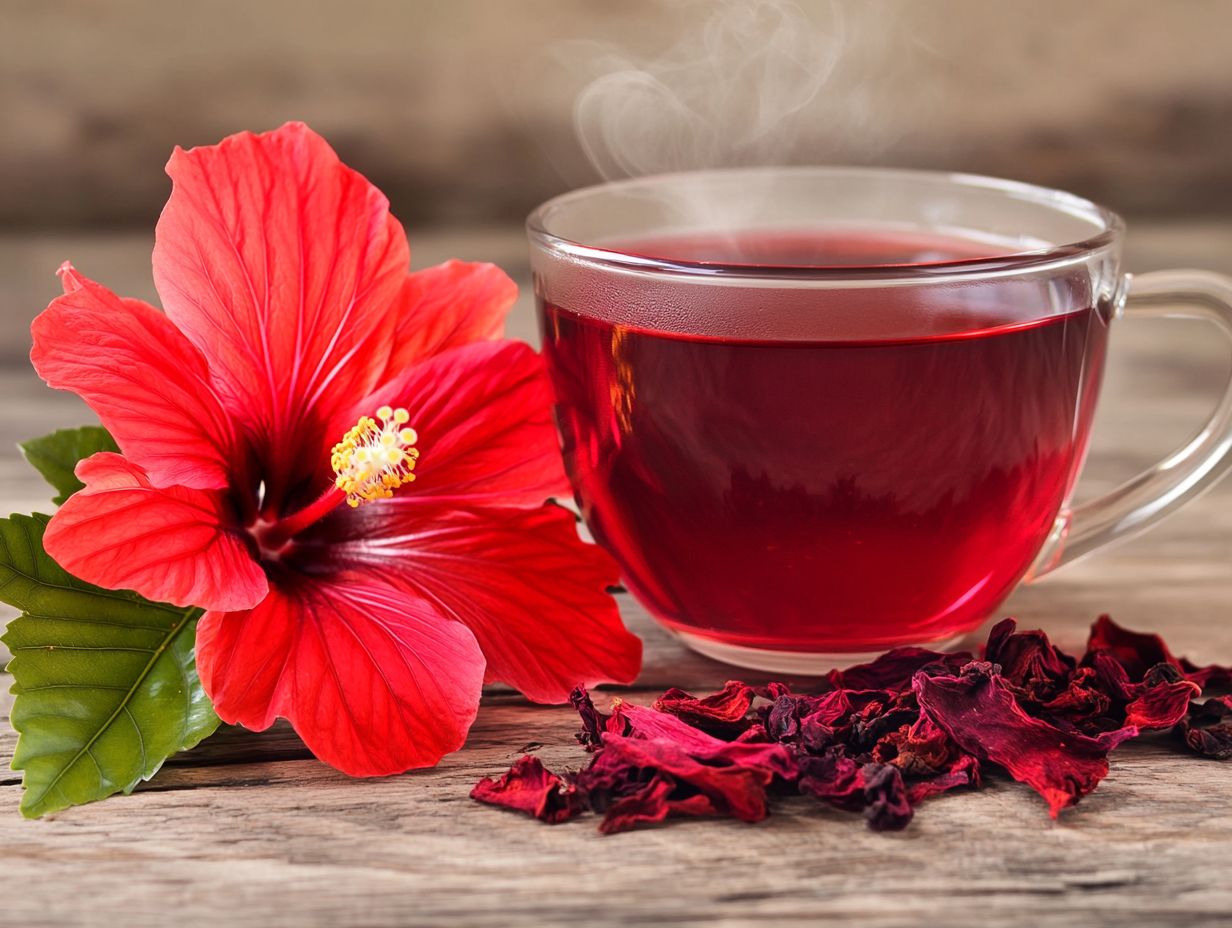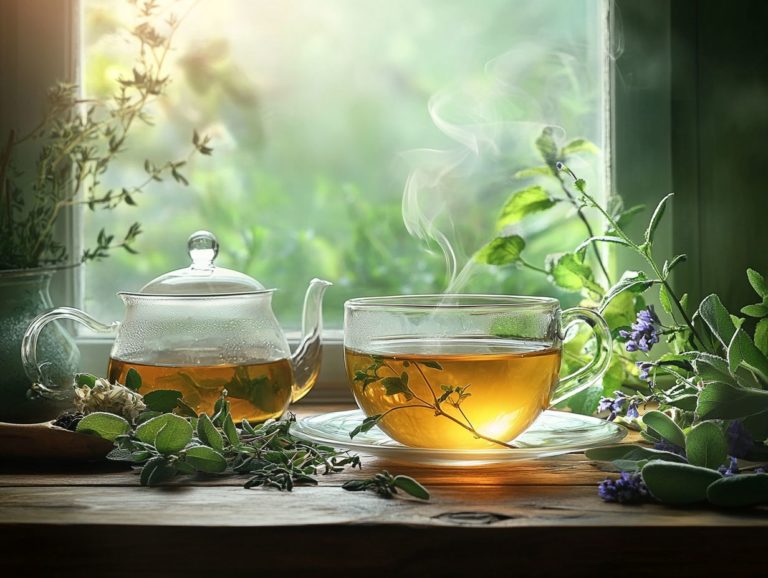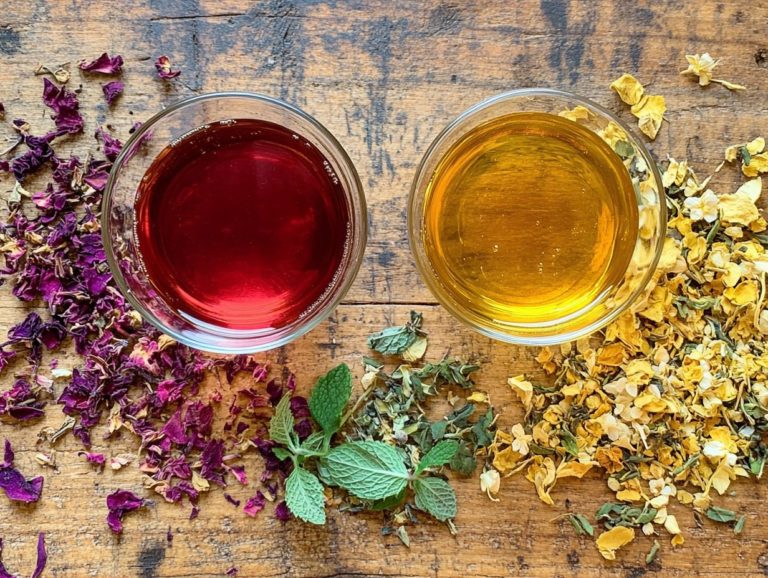How to Use Hibiscus in Herbal Teas
Hibiscus tea is a vibrant and flavorful tea that has captured attention, not just for its refreshing taste but also for its remarkable health benefits.
This article delves into the essence of hibiscus tea, showcasing its various advantages and culinary applications. Discover exciting methods to craft the perfect cup! Explore exciting flavor combinations with other herbs, and learn essential safety considerations to keep in mind.
Whether you re a seasoned tea enthusiast or a curious newcomer, there s something here for you to savor and enjoy!
Contents
Key Takeaways:

- Hibiscus tea offers health benefits, such as lowering blood pressure and improving digestion.
- Aside from being a refreshing beverage, hibiscus can add unique and tangy flavors to culinary dishes.
- When preparing hibiscus tea, experiment with different methods and recipes or combine it with other herbs for more flavor and benefits. Be aware of potential side effects and precautions.
What is Hibiscus Tea?
Hibiscus tea is made from the beautiful hibiscus flowers of the hibiscus sabdariffa plant. It s a beloved herbal tea known for its tart flavor and refreshing qualities.
This herbal tea has deep cultural roots, especially in Jamaica, where it s called Jamaican sorrel or agua de Jamaica.
Packed with antioxidants and vitamin C, hibiscus tea is not just a delightful beverage option; it also boasts an array of health benefits, making it a cornerstone in both culinary and medicinal practices across various regions, including Mexico and the Caribbean.
Preparing hibiscus tea is easy. Simply steep dried hibiscus petals in hot water, and voil you re left with a deep crimson brew that s as pleasing to the eye as it is to the palate. Globally, you ll discover variations of this herbal delight, with recipes that include spices, fruits, or sweeteners to elevate its flavor profile.
Known for its cool, invigorating taste, hibiscus tea is often enjoyed chilled, making it a perfect match for warm weather.
In some cultures, hibiscus tea takes on a ceremonial significance, symbolizing hospitality and joy. With its potential benefits for lowering blood pressure and aiding digestion, it has garnered a following among health enthusiasts seeking a flavorful yet beneficial drink.
Benefits and Uses of Hibiscus Tea and Hibiscus Blends
Hibiscus tea presents a wealth of benefits and uses, establishing itself as a versatile gem in your herbal tea collection. Known for its refreshing flavor and striking hue, this herbal infusion is more than just a delightful beverage; it’s celebrated for its remarkable health advantages, such as its effectiveness in lowering blood pressure and cholesterol levels.
Hibiscus tea is a great base for many culinary creations and drink recipes, inviting you to explore your creativity in crafting both hot and iced tea delights.
Health Benefits
Don’t miss out on the incredible health benefits of hibiscus tea! It s a flavorful drink that can enhance your well-being.
The health benefits of hibiscus tea are extensive and well-documented, making it a popular choice among herbal remedies for various ailments.
This tea, especially from the Hibiscus sabdariffa variety, has been shown in studies to lower systolic blood pressure by up to 10 mmHg. The secret lies in its anthocyanins (a type of antioxidant), which promote vascular health by improving endothelial function. You might appreciate its ability to lower LDL cholesterol levels, thus reducing cardiovascular risks.
But the advantages don t stop at physical health; hibiscus tea also seems to have mood-stabilizing effects. Experts suggest that its calming properties may help alleviate anxiety and depression symptoms, providing a natural alternative for your mental wellness.
The tea also has anti-inflammatory effects that may help combat stress and enhance your overall emotional resilience, making it a multifaceted ally in your modern health management journey.
Culinary Uses

Hibiscus tea is not just a delicious drink; it s a great cooking ingredient that can elevate your dishes and drinks. Think of it as the star of agua de Jamaica or a vibrant base for flavored sodas and unique hibiscus blends.
This herbal infusion offers a unique tart flavor and a stunning color that can transform ordinary recipes into extraordinary experiences. You ll love crafting your own hibiscus syrup to enhance desserts and cocktails, making it a must-have for both chefs and home cooks.
Hibiscus is versatile and invites you to explore a wide array of recipes, adding excitement to both savory and sweet creations. In savory dishes, consider using it to marinate meats (soak in a mixture to enhance flavor) or brighten up salads with a tangy dressing. For those interested in tea, check out how to brew herbal tea with loose leaves to enjoy its benefits in beverage form.
For desserts, a drizzle of hibiscus syrup over pancakes, ice cream, or yogurt can create an eye-catching presentation. Homemade hibiscus jam, with its striking hue, is perfect for spreading on toast or using as a filling in pastries.
Blend it into smoothies or fruit cocktails, and hibiscus imparts a refreshing tartness that elevates flavor profiles in astonishing ways. For those looking to enhance their beverages even further, discovering how to spice up your herbal tea can lead to exciting flavor combinations. With its unique characteristics, hibiscus has the potential to transform simple ingredients and inspire culinary adventures, from enticing starters to irresistible sweet finales.
Preparing Hibiscus Tea
Preparing hibiscus tea is a simple and rewarding task, culminating in a vibrant and flavorful infusion. Whether you choose to indulge in a steaming cup or prefer a refreshing cold brew, the versatility of hibiscus offers you various brewing methods to match your taste preferences.
For the best flavor, use dried petals or fresh flowers. This ensures you extract the fullest flavor and health benefits, allowing you to savor a delightful hibiscus infusion. Additionally, learning how to choose the right herbs for tea can enhance your tea experience.
Methods and Recipes
There are numerous ways to prepare hibiscus tea, each offering a distinct flavor profile and a canvas for your creativity in crafting delightful drink recipes. From traditional brewing techniques to refreshing cold preparation methods, hibiscus tea can be enjoyed in various forms, including invigorating hibiscus iced tea and effervescent hibiscus drinks.
For a hot preparation, simply steep dried hibiscus petals in boiling water for about five to ten minutes; this will deliver a rich, tangy flavor that warms the soul. If you prefer a chilled option, brew the tea hot and then cool it down with ice for a revitalizing hibiscus iced tea, perhaps enhanced with fresh mint leaves and a slice of lemon for that extra zing. To learn more about making your own herbal tea at home, check out this guide on herbal tea. Consider a sweetener like honey for added flavor.
Combine hibiscus with other delightful flavors, such as pineapple for a tropical twist or ginger for a vibrant kick. To truly elevate your presentations, garnish your creations with fresh fruit, like pomegranate seeds or a sprig of mint. By experimenting with various infusion times and incorporating herbs or spices, you can even learn how to make herbal tea with fresh herbs, making the possibilities for crafting exquisite hibiscus beverages truly endless.
Combining Hibiscus with Other Herbs
Combining hibiscus with other herbs can truly elevate your tea-drinking experience, presenting a delightful array of flavor combinations and health benefits.
Imagine pairing fresh mint, cinnamon, ginger, or cloves with the tart notes of hibiscus tea; each blend offers a unique twist that caters to your personal palate, enhancing the drink recipes you create.
By experimenting with different herbs, you can not only enhance the flavor but also amplify the therapeutic properties of your hibiscus infusion, crafting a beverage that is both enjoyable and tailored just for you.
Start experimenting with hibiscus today for a refreshing twist on your beverages! Did you know hibiscus tea is rich in Vitamin C?
Flavor Combinations and Benefits

Flavor combinations with hibiscus tea create delightful, health-enhancing drinks. Herbs like fresh mint, cinnamon, and ginger can craft unique infusions that excite your taste buds.
Fresh mint gives a refreshing aroma. It can be especially revitalizing on a hot day. Cinnamon also enhances the flavor and may help regulate blood sugar levels. Ginger adds a zesty kick and is well-known for its digestive benefits. Cloves contribute a slightly sweet and spicy profile, offering antioxidant properties that enrich your tea experience.
Together, these ingredients elevate the flavor profile and foster a holistic sense of well-being.
Safety Considerations
Hibiscus tea is safe for many, but keep certain safety considerations in mind. Individuals with high blood pressure or diabetes should be cautious, as hibiscus can affect these conditions.
It s essential to consult with a healthcare professional before making this delightful beverage a regular part of your routine, especially if you have any underlying health conditions.
Possible Side Effects and Precautions
Hibiscus tea is delightful but comes with potential side effects. Excessive consumption can cause dizziness for those with high blood pressure. For those managing diabetes, it’s wise to be cautious, as hibiscus may interact with certain medications.
If you have liver conditions, the tea’s high acidity could aggravate specific symptoms or interfere with treatments. Moderation is key; overindulging in hibiscus tea can lead to more pronounced adverse effects.
Consulting a healthcare provider before making this herbal infusion a regular part of your routine is advisable, especially if you re on medication or have pre-existing health concerns.
When consumed responsibly, hibiscus tea can offer a wealth of health benefits, allowing you to enjoy its unique flavor while keeping your well-being at the forefront.
Frequently Asked Questions
What is hibiscus?

Hibiscus is a flowering plant commonly used in herbal teas for its unique flavor and potential health benefits. It is rich in antioxidants, vitamin C, and minerals, making it a popular ingredient in natural remedies.
How do I prepare hibiscus for herbal tea?
To make hibiscus herbal tea, use either fresh or dried hibiscus flowers. For fresh flowers, rinse them thoroughly and remove the green calyx from the base of the flower. For dried flowers, steep 1-2 teaspoons in hot water for 5-10 minutes.
Can hibiscus be mixed with other herbs in herbal tea?
Absolutely! Hibiscus pairs well with a variety of other herbs and spices such as ginger, cinnamon, and mint. Experiment with different combinations to find your perfect blend.
How does hibiscus tea taste?
Hibiscus tea has a tart and slightly tangy flavor, similar to cranberries. It can be enjoyed hot or cold, and you can adjust the strength of the flavor by adding more or less hibiscus flowers.
Ready to explore the vibrant world of hibiscus tea? Start brewing your perfect cup today!
What are the potential health benefits of drinking hibiscus herbal tea?
Hibiscus tea is linked to many health benefits. These include better digestion, lower blood pressure, and reduced inflammation.
More research is needed to confirm these benefits.
Can hibiscus be used in other forms besides tea?
Yes! Hibiscus comes in many forms, including supplements, extracts, and skincare products.
Be sure to check with a healthcare professional before trying something new!






